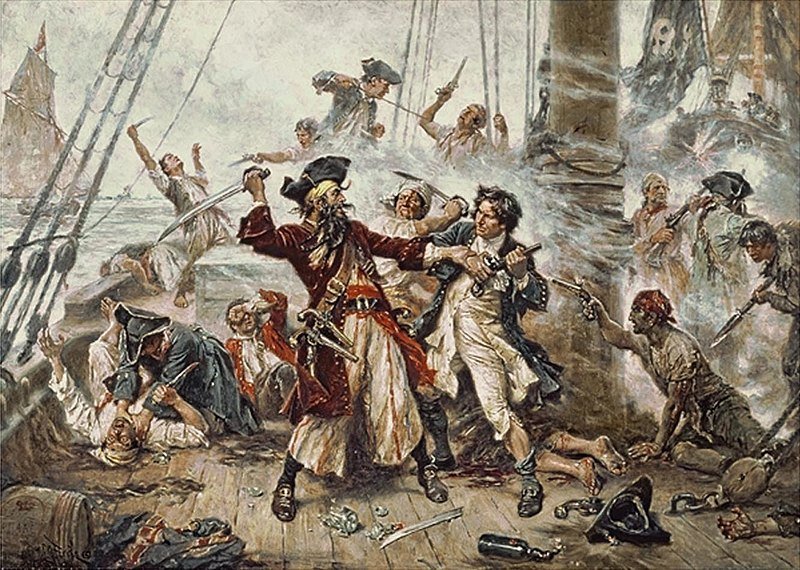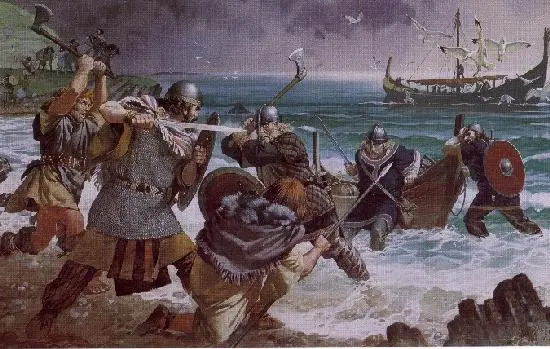trade and navigation. They were infamous for their daring exploits, treacherous attacks, and their thirst for treasures. However, pirates are not just a monolithic group of swashbuckling outlaws. Instead, their were different types of pirates, with distinct characteristics, modes of operations, and motives.
In this article, we will explore the various types of pirates, from the ancient marauders of the Mediterranean to the deadly vikings of Northern Europe. Understanding the diversity of pirates can help us appreciate the complex history and nuances of piracy, and its impact on world history.
The Buccaneers

During the 17th century, the buccaneers were semi-lawful sailors and soldiers who attacked Spanish ships and ports in the Caribbean Sea. The Spanish considered the region of the Caribbean Islands to be their own treasure house, where they transported gold, silver, and other treasures from the New World to their homeland. However, England, France, and other European nations also had an interest in the wealth of the Caribbean islands and American continents.
The buccaneers originated from European settlers and adventurers who inhabited Hispaniola and other nearby Caribbean islands. They earned a living by selling the smoked meat of wild cattle and boars to passing ships.
They were often seen cooking meat on wooden frames and drying it in the sun, which is where they got their name from the Tupí Indian hunters, who used similar frames called boucanes.
As the early buccaneers were under constant threat, they were forced to change locations of living. In the mid-1620s they found a safe establishment in the island of Tortuga. Eventually, they became so well organized that they started attacking Spain instead of just encountering passing merchant’s vessels.
The buccaneers’ attacks were based only on Spanish vessels, and they organized both naval and land attacks, regularly harassing towns in American Continents since 1630. They eventually acquired letters of marque and official authorization from their colonial governments for legal attacks on enemy property.
The buccaneers became more legitimate, and when the war between England and Spain ended in 1670, the English government forbade any further buccaneers’ activities. Despite this, many Frenchmen continued to raid Spanish colonies until 1697. With the truce between France and Spain, even the last buccaneers disappeared from the Caribbean.
The Corsairs
Corsairs were organized pirate fleets that caused havoc in two different areas of the world during the 16th-19th centuries. The Barbary Corsairs operated out of large ports along the African coast, with cities such as Tripoli, Tunis, and Algiers being notable centers.
They built fast and durable ships using both the expertise of several English privateer captains who elected to become corsairs and Naval technologies developed within Europe. The primary reason for the Corsair raids was to capture the Christian slaves that could be traded throughout the Ottoman empire, in addition to acquiring the wealthy merchant shipping of the Western Mediterranean and France.
Between the 16th and 19th centuries, it is believed that the Barbary Corsairs obtained between 800,000 and 1.25 million people as slaves. European naval powers began organizing military might to fight the corsairs openly after the peak of their activity during the early to mid-17th century.
Additionally, governments pressured the Ottoman empire with trade blockades if such brazen acts of Corsair piracy were not put into check. European countries that were within easy reach of Corsair raiding parties preferred not to build new coastal settlements until the mid-19th century.
The term “corsair” quickly became a synonym for any unsanctioned pirate activity since the Barbery Coast pirates caused much damage in Coastal Europe and the Mediterranean. During the age when the English, French, and Dutch governments fought against Spain, many private and military vessels became privateers fighting forces that strived to disrupt Spanish naval trade and cause damage to Spanish cities and possessions.
Although the general piracy covered a larger territory, privateers were primarily located in the Caribbean. Many privateers claimed to have official government support to harass Spain’s interest in the Caribbean, although many did not. All captured privateers were put to death no matter if they had royal orders or not.
After the War of the Spanish Succession in 1715, many of the previously active privateers did not stand down. Rather, they openly became pirates and continued harassing merchants of all nationalities forcing European governments to organize their military fleets into ending most of the pirate activity from the Atlantic.
The Pirates

Piracy is an act that goes against the universal law and is considered a criminal offense in all countries. Pirates were seamen who attacked and robbed ships, and engaged in illegal activities such as smuggling and slave trading.
They did not have any legal rights and their actions were considered unauthorized. Privateers or buccaneers were similar to pirates, but they were not treated like criminals because they had permission from their government to attack and seize enemy ships.
Pirates were motivated by their hunger for adventure, danger, and fame, which made piracy a way of life for them. They operated in various regions including the Indian Ocean, the west coasts of Africa, and the Caribbean. Female pirates also existed and were known to be womanizers.
Despite being romanticized in modern media, piracy was cruel, violent, and dangerous. A pirate’s career typically lasted only 2-3 years before they were caught or died in battle. In the past, piracy was punished with death in almost all countries. Today, piracy is still a global issue that affects seafarers, the economy, and the safety of maritime trade.
The Privateers

Privateers, while sometimes categorized as pirates, actually shared more similarities with navy soldiers as many of their actions were considered legal. The term “privateer” could refer to the ship’s captain, owner, crew, or vessel itself and they were typically authorized during times of war by a government or trading company.
Their main objective was to capture or destroy enemy vessels and take valuable items as spoils of war, all of which were authorized through the use of letters of marque and reprisal.
Both the privateers and their respective nations benefited greatly from these deals. Sailors were given ample opportunity for profitable and exciting work without fear of punishment, while the government essentially received a free navy as they didn’t have to pay or supply the crews.
In exchange for this immunity, privateers agreed to give a percentage of their plunder to their backers, leading to great earnings on both sides.
Although international law permitted privateers with letters of marque to avoid being treated as prisoners of war, they were still viewed negatively by enemy nations and often faced piracy charges. Privateers were most active during the 16th-18th centuries when European nations vied for control over the New World.
Notable figures, such as Sir Francis Drake and Kanhoji Angria, built reputations as successful privateers, but the practice was ultimately declared illegal in 1856 with the Declaration of Paris.
Vikings

The Vikings, who lived in tribes in North Europe were known for being extraordinary warriors who raided and looted many European countries such as England, France, Germany, Ireland, Italy, Russia, and Spain.
They also settled in Greenland and Iceland before Europeans even knew about those islands. Famous Viking explorer, Leif Ericson found North America 500 years before Columbus and named the new land Vinland. His sister Freydís Eiríksdóttir also traveled to Vinland and forever engraved her name in the Norse legends.
The term “Viking” probably came from the name of the pirate center in southern Norway during their age, and it was used to describe fighting like a pirate or warrior. However, not all Scandinavians fought like pirates all the time, and most led peaceful lives.
Each Viking community had a council called the Thing or Folkmoot, which was more important than the king or the chief of the community. It was responsible for making laws and judging criminals based on the laws it made. Waging war was decided by the Thing as well.
The council consisted of nobles and freemen, while slaves could not have any influence over the Thing. The Vikings’ equipment included swords, axes, knives, cold shields, and strong helmets, making them appear like warriors from tales.
The Vikings spoke a Germanic language with two dialects, both of which they understood. They wrote using runes and followed their religion, which was based on the main gods Odin, Thor, and Freya. Wednesday was considered a holy day and held equal importance to Sunday nowadays. The Vikings were allowed to have multiple wives based on their wealth and had two meals daily – one in the morning and one in the evening.
Apart from being excellent warriors and raiders, the Vikings were also known for their ship-building skills. They had various types of ships, including ones that could navigate near the shore without any issues because they were easy to navigate. Despite not having any advanced technology, the Vikings could navigate their ships based on landmarks and seabirds.
